|
The
|
THE BURGENLAND BUNCH NEWS - No. 232 May 31, 2013, © 2013 by The Burgenland Bunch All rights reserved. Permission to copy excerpts granted if credit is provided. Editor: Thomas Steichen (email: tj.steichen@comcast.net) Our 17th Year. The Burgenland Bunch Newsletter is issued monthly online. It was founded by Gerald Berghold (who retired Summer 2008 and died in August 2008). |
Current Status Of The BB: * Members: 2154 * Surname Entries: 7205 * Query Board Entries: 5154 * Staff Members: 17 |
This newsletter concerns: 1) THE PRESIDENT'S CORNER 2) AN AUSTRIAN-HUNGARIAN BADGE 3) JOHN DIKOVICS: A JOURNEY FROM KAISERSDORF (by Stephen John Dikovics) 4) THE LAKE CORNER (by Hannes Graf) 5) DNA AND OUR CROATIAN ROOTS (by Frank Paukowits) 6) HISTORICAL BB NEWSLETTER ARTICLES: - CANADIAN ARCHIVES (from Mike Huber) 7) ETHNIC EVENTS 8) BURGENLAND EMIGRANT OBITUARIES (courtesy of Bob Strauch) |
1) THE PRESIDENT'S CORNER (by Tom Steichen)  Concerning
this newsletter, after the Bits and Pieces in my President's Corner
below, we get down to full-length articles starting with one wherein Robert Thullner,
of Herreid, SD, asked me (and I ask you) if we recognize an interesting
Austrian-Hungarian Badge. That is followed by an article from Stephen Dikovics,
who tells us about his Burgenland-born grandfather, Rev. John Dikovics, who was
ordained a Catholic priest in Hungary but became a Presbyterian minister after emigrating to
the United States. Next comes an article by Hannes Graf concerning Burgenland's
Lake Corner (Seewinkel), which has special interest to its author and also its
editor, as we both have roots in that area. Next, Frank Paukowits tells us a bit
of what his DNA Project is learning about Croatian Roots in
Burgenland. Concerning
this newsletter, after the Bits and Pieces in my President's Corner
below, we get down to full-length articles starting with one wherein Robert Thullner,
of Herreid, SD, asked me (and I ask you) if we recognize an interesting
Austrian-Hungarian Badge. That is followed by an article from Stephen Dikovics,
who tells us about his Burgenland-born grandfather, Rev. John Dikovics, who was
ordained a Catholic priest in Hungary but became a Presbyterian minister after emigrating to
the United States. Next comes an article by Hannes Graf concerning Burgenland's
Lake Corner (Seewinkel), which has special interest to its author and also its
editor, as we both have roots in that area. Next, Frank Paukowits tells us a bit
of what his DNA Project is learning about Croatian Roots in
Burgenland.The remaining articles are our standard sections: Historical Newsletter Articles, and the Ethnic Events and Emigrant Obituaries sections. You may note that our Historical Article was written this month by Mike Huber, that Ethnic Events are submitted by a number of people, and that the Emigrant Obituaries are submitted by Bob Strauch. Thus, most of this newsletter was written by authors other than your Editor, a situation I greatly appreciate! I hope you enjoy hearing from your fellow BB members as much as I enjoy the "month off" from composing most of the articles. But I start with some bits and pieces:  The
Smithsonian Folklife Festival: The Smithsonian Folklife Festival, held Wed-Sun, June
26-30 and July 3-7, has special interest to Burgenländers this year. The
Smithsonian Folklife Festival: The Smithsonian Folklife Festival, held Wed-Sun, June
26-30 and July 3-7, has special interest to Burgenländers this year.One of the featured programs is Hungarian  Heritage:
Roots to Revival, a program that "highlights the vitality of Hungary’s cultural
heritage in music, costume, crafts, games, food, wine, and dance—including the 'dance hall
movement,' the grassroots revival of village dance traditions in urban settings." More
info about this program is at
http://www.festival.si.edu/mobile/2013/Hungarian_Heritage/. Heritage:
Roots to Revival, a program that "highlights the vitality of Hungary’s cultural
heritage in music, costume, crafts, games, food, wine, and dance—including the 'dance hall
movement,' the grassroots revival of village dance traditions in urban settings." More
info about this program is at
http://www.festival.si.edu/mobile/2013/Hungarian_Heritage/.The Festival is held outdoors on the National Mall in Washington, D.C., between the Smithsonian museums. There is no admission charge. Given this is in DC in high summer, visitors should dress for hot and humid weather. Visitors are also advised to use Metrorail (use the Smithsonian station Mall exit or the nearby Federal Triangle and National Archives stations). Other featured programs are 'One World, Many Voices: Endangered Languages and Cultural Heritage' and 'The Will to Adorn: African American Diversity, Style, and Identity.' For more information, see: http://www.festival.si.edu/mobile/index.aspx. A Festival site map can be found at: http://www.festival.si.edu/mobile/map.aspx. [This item added to Newsletter on 1 June 2013] BB Member Video: Our Burgenland Connection BB Member Joe Gray created a truly special gift for his wife Laura... an 18-minute movie about her Burgenland family and the trip she and Joe took to Burgenland to explore her history. Joe kindly shares it with us: You can click the Austrian Parish Register Digitization Project: BB Member Dean Wagner wrote:
I replied to Dean (in part): Hi Dean, I was aware that St. Polten was
approaching completion of their scanning. Some parishes were searchable online over a year ago
(I'm sure I mentioned it somewhere in the BB Newsletter) but I didn't know when they would
complete everything. Apparently they have done so now so I'll insert a note into the next
newsletter. Thanks for the heads up!
I replied to Mike: Hi Mike, I have never heard of any such records being
available. My first thought, given what you say, is that you are referring to the early-1700s
Donauschwaben and Siebenbürgen Sachsen emigrations to repopulate land after the Turks were
expelled from Hungary, etc. The primary embarkation points for that were Ulm and Regensburg.
|
2) AN AUSTRIAN-HUNGARIAN BADGE 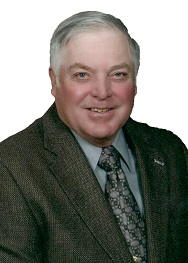 Robert
Thullner, of Herreid, SD, writes (in part): Tom, We found a cloth embroidered badge
from an Austrian event probably held in St. Paul in the late 1920s to 1930s or maybe even into
the 1940s. It is about 2 inches wide and about 5 inches long with gold tied protruding strings
attached. It is written in German with Österreich and St. Paul. ANY IDEAS? Robert
Thullner, of Herreid, SD, writes (in part): Tom, We found a cloth embroidered badge
from an Austrian event probably held in St. Paul in the late 1920s to 1930s or maybe even into
the 1940s. It is about 2 inches wide and about 5 inches long with gold tied protruding strings
attached. It is written in German with Österreich and St. Paul. ANY IDEAS?I replied: Hi Robert, Given what you told me, I can't begin to guess what it was for. Is there more writing on it? Alternatively, can you snap a digital image and email it to me? Perhaps I can learn something of it that way. As an aside, I note you name John Thullner as emigrant ancestor in your member entry and say you do not know exactly when he emigrated.  The
answer is he departed Southampton, England, aboard the SS Leviathan on Oct 9, 1923, and
arrived at Ellis Island on Oct 15. He is listed as a single, 23-year-old ethnic German farmer
from "Moenchshof," Austria. He lists his father, Johann Thullner of Moenchshof as nearest
relative and is going to Edgemont, SD, to join his uncle, John Koller, Sr. there. He is listed
as 5'6", blonde hair, green (or gray -- can't tell from the abbreviation) eyes, born in
Moenchshof. The
answer is he departed Southampton, England, aboard the SS Leviathan on Oct 9, 1923, and
arrived at Ellis Island on Oct 15. He is listed as a single, 23-year-old ethnic German farmer
from "Moenchshof," Austria. He lists his father, Johann Thullner of Moenchshof as nearest
relative and is going to Edgemont, SD, to join his uncle, John Koller, Sr. there. He is listed
as 5'6", blonde hair, green (or gray -- can't tell from the abbreviation) eyes, born in
Moenchshof.Edgemont is way over in the southwest corner of the state... so how did you end up in north-central SD? Robert replied: I am in the process of sending the badge to my daughter in the Twin Cities' area and she will send you the picture. We are compiling a booklet. John, my dad, did bridge building and worked on one on the south edge of Herreid. He found some surnames from Burgenland in our town and felt at home and stayed. The Austrian names were Lunzer, Stellflug, Senftner others were in St. Paul, MN -- Weiss, Graner, Kirchner, Hoffmann. Dad worked as a meat cutter in the winter months in St. Paul and returned to his farm to seed crops in the spring until 1942. Thanks for your interest, Robert I replied: OK Robert, I'll await the picture from your daughter. In thinking about it more, I'm wondering if it might relate to either the St. Paul Winter Carnival (which started in 1885, I believe) or one of the St. Paul churches...I think two of them (St Agnes and St. Bernard's) had a strong Austrian link. As you may know (since I write about them so often), my Burgenländers came out of the Neusiedl district (Wallern and Halbturn) like yours, and emigrated to Minnesota (with some in St. Paul and a few eventually in the Dakotas). Further, Weiss is one of my surnames. So, your history definitely rings a bell with me. I find it interesting in how people switched so easily between jobs and over such long distances back then. Not like the current world, is it?  Karen
Thullner, Robert's daughter, wrote (in part): Hello Tom, Here is a scan of the badge
Robert was talking about [Ed: click on the image to the right to see a larger version...
when it come up, click again for a still larger version]. Translated, it is roughly:
Osterreiqhisqh - Ungarishqher (Austria-Hungarian) Unterstutiungs - ?erein
(Assistance/aid/support-holiday?) ?: I think it looks like a Q, but it makes sense to be F. I
couldn't find the typeface to confirm. Karen
Thullner, Robert's daughter, wrote (in part): Hello Tom, Here is a scan of the badge
Robert was talking about [Ed: click on the image to the right to see a larger version...
when it come up, click again for a still larger version]. Translated, it is roughly:
Osterreiqhisqh - Ungarishqher (Austria-Hungarian) Unterstutiungs - ?erein
(Assistance/aid/support-holiday?) ?: I think it looks like a Q, but it makes sense to be F. I
couldn't find the typeface to confirm.I also found it in a book online. The book is in German and I didn't take time to translate. I couldn't find out any further information. So, any information would be helpful. Thank you I replied to Karen and Robert: You are right, it is a badge of the St. Paul Österreichisch-Ungarischen Unterstützungsverein (Austrian-Hungarian Support Association) [ED: "Austrian-Hungarian Beneficial Society" may be a better translation]. According to the Burgenländische Gemeinschaft newsletter (#361, Sept/Oct 1999): "In St. Paul gab es den Österreichisch-Ungarischen Kranken-Unterstützungsverein, der vor dem Ersten Weltkrieg gegründet wurde und zum großen Teil aus Burgenländern bestand. In den 20er Jahren hatte er 300 Mitglieder. 1970 wurde der Verein aufgelöst. Jeder der noch lebenden Mitglieder erhielt damals 72 Dollar." Translation: In St. Paul, there was the Austro-Hungarian Health-Support Organization that was founded before the First World War and largely consisted of Burgenländers. Within 20 years, it had 300 members. The club was disbanded in 1970. Each of the surviving members at that time received $72. So, this was one of the many ethnic-specific associations of the era that provided disability, sickness and death (burial) insurance for its members along with a social meeting place. People typically stopped in weekly to pay dues that covered both the insurance and social membership. Modern insurance and integration into “American” society of the member families eventually led to the demise of such associations [ED: that is, insurance companies, religious charities, credit unions and democratic governments now perform many of the functions that ethnic- or culturally-affiliated mutual benefit associations once performed]. Now there are very few surviving associations and most of those only have a social function. According to the newsletter note above, they [ED: the St. Paul Unterstützungsverein] divided the remaining assets when they closed it down in 1970. Western Badge and Novelty Company [ED: the manufacturer name was on the back of the badge, image not shown] existed 1908-1973 (and created badges for all sorts of organizations), so that does not help narrow when the badge was created. Perhaps an expert, if such exist on badges, (say, at the Minnesota Historical Society) could give an estimate of when the badge was created, but I doubt we would every learn its actual purpose. 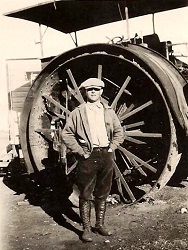 You
may recall that I am editor of the Burgenland Bunch Newsletter… as such, I wouldn’t mind
publishing a short note about this. I find it to be an interesting topic worth sharing wider.
Perhaps a reader will recognize it and we might learn more. Will it be OK if I write this up
for a newsletter and post an image of the badge? If so, I may ask for more information about
who you believe originally received the badge and why they would have been connected to this
association. I’m sure the likely answer is your father/grandfather John and that he was a
member due to working in St. Paul, but you haven’t actually told me that yet. You
may recall that I am editor of the Burgenland Bunch Newsletter… as such, I wouldn’t mind
publishing a short note about this. I find it to be an interesting topic worth sharing wider.
Perhaps a reader will recognize it and we might learn more. Will it be OK if I write this up
for a newsletter and post an image of the badge? If so, I may ask for more information about
who you believe originally received the badge and why they would have been connected to this
association. I’m sure the likely answer is your father/grandfather John and that he was a
member due to working in St. Paul, but you haven’t actually told me that yet.Thanks for sharing this with me, Tom Steichen [Ed note: Robert did give permission, thus this article exists! He also replied with more detail...] Robert wrote (in part): Tom: The best of my recollection is that my dad did bridge construction until the late 1920s. He also was a worker on a bridge that crossed the Mississippi River in St. Paul, probably in the late 1920s. I believe that there was a worker and rededication reunion in the past 15 years. In the early 1930s, because of Austrian surnames in the Herreid area, he was given an opportunity to rent and share farm. He worked at a local culvert factory in the summer making culverts for road construction and grain-farmed after work hours. He is credited for instigating the present redi-mix complex by saving extra hand mixed concrete and making a form for solid blocks to construct the building. The pay for making the culverts was 33 cents per hour. In the winter time, up until about 1940, he traveled back to St. Paul to cut meat at a hog-kill plant. At this new time frame, he went into the business of raising beef cattle. He was the first in our area to feed grain to young cattle. Then, at the age of 42, he married my mother and had two children. Margaret in Chicago, a retired lab technician, and me. My mother's first husband died and had two daughters that were young. He then purchased the farm land and continued in production agriculture until retirement in 1965 and death in 1973 at age 73. Karen will forward some pictures. The badge was in my dad's memorabilia so I presume it is his. Best to all, Bob So, to you, our readers: Is this badge familiar to any of you and/or were any of your family members associated with the Österreichisch-Ungarischen Kranken-Unterstützungsverein in St. Paul? If so, please write and share what you know! As for Robert's original question, we know the organization behind the badge and can reasonably assume that it dates after 1923 (the year of John's arrival in the US) and certainly before 1970. One can also assume it dates from the time John worked in St. Paul, as I doubt he would have learned of the group while in southwestern or north-central South Dakota. John stopped working winters in St. Paul around 1940 and switched to farming fulltime in the Dakotas thereafter, which likely limits the time range of the badge to between 1923 and 1940. It would be nice to have a specific year and a purpose for the badge... do write if you know either! |
3) JOHN DIKOVICS: A JOURNEY FROM KAISERSDORF (by Stephen John Dikovics) As a young boy in the late 1950s I would sit with my grandfather almost every Sunday afternoon on the third floor of his Glen Ridge, NJ, home and stare, as any unassuming boy would, at his white hair and trembling hands. 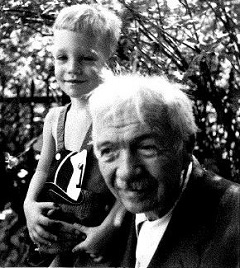 His
name was Dr. John Dikovics, at that time a retired college professor. He didn’t speak a great
deal then, already in his 80s and unable to walk without assistance. But my grandfather was
always happy to see me, perhaps, in part, because my name was Stephen, which I found out some
40 years later was his father’s name. And, at my young age, I didn’t have the foresight to ask
him the questions I would latter wonder about as an adult. Where did you live in Hungary?
Why did you become a Catholic priest? How did a young man from a tiny farming village evolve
into a scholar and educator, fluent in German, Greek, Latin, and Hungarian? Flash forward
55 years and the answers to those questions have become clear. His
name was Dr. John Dikovics, at that time a retired college professor. He didn’t speak a great
deal then, already in his 80s and unable to walk without assistance. But my grandfather was
always happy to see me, perhaps, in part, because my name was Stephen, which I found out some
40 years later was his father’s name. And, at my young age, I didn’t have the foresight to ask
him the questions I would latter wonder about as an adult. Where did you live in Hungary?
Why did you become a Catholic priest? How did a young man from a tiny farming village evolve
into a scholar and educator, fluent in German, Greek, Latin, and Hungarian? Flash forward
55 years and the answers to those questions have become clear.![Gravestone of greatgrandfather Stefan Dikovich in Kaisersdorf [see note ii]](232/dikovits_grave.jpg) My
grandfather, John Dikovics (recorded as Dikovich, in the Roman Catholic parish registers), was
born on March 12, 1875 in Császárfalu, Hungary (now Kaisersdorf, Austria) to Stephen (Stefan)
Dikovich, the local primary school headmaster, and Rosalia Trobollovich of Weingraben, my
great-grandmother. Stephen was a teacher and headmaster of the primary school in Kaisersdorf
from 1873 to 1905. The entry in the parish register for my great-grandparents' marriage on
February 10, 1874, shows Elisabetha Dikovich as Stephen’s parent and Jacobus and Theresa
Trobollovich as Rosalia’s parents. The surname DIKOVIC is of Croatian origin; DIKOVIÆ =
Croatian spelling. The name for Kaisersdorf was/is Kalištrof. They (Croatians) have been there
since the 1500s, having fled from the Ottoman Turks.i My
grandfather, John Dikovics (recorded as Dikovich, in the Roman Catholic parish registers), was
born on March 12, 1875 in Császárfalu, Hungary (now Kaisersdorf, Austria) to Stephen (Stefan)
Dikovich, the local primary school headmaster, and Rosalia Trobollovich of Weingraben, my
great-grandmother. Stephen was a teacher and headmaster of the primary school in Kaisersdorf
from 1873 to 1905. The entry in the parish register for my great-grandparents' marriage on
February 10, 1874, shows Elisabetha Dikovich as Stephen’s parent and Jacobus and Theresa
Trobollovich as Rosalia’s parents. The surname DIKOVIC is of Croatian origin; DIKOVIÆ =
Croatian spelling. The name for Kaisersdorf was/is Kalištrof. They (Croatians) have been there
since the 1500s, having fled from the Ottoman Turks.iThe following is an excerpt from a 1950 newspaper interview in connection with a dinner, honoring the life and work of Dr. John Dikovics, to be held at the Hungarian Presbyterian Church of Newark.iii
[Further clarification based on family discussions disclosed that my grandfather met
Clementina Eles and, dismayed that he could not marry, left the priesthood. John Dikovics
married on August 26, 1903, in Vienna. On September 14, 1903, my grandparents left from Le
Havre, France, bound for New York.iv]
My grandfather passed away in April 1963 at the age of 88. It can be said that his journey
from his homeland of Kaisersdorf to “disrupt the ties of tradition” was a success.
Reference works: |
4) THE LAKE CORNER (by Hannes Graf) We have been republishing some articles Hannes wrote over the past two years for placement on his personal site, Spirit of Gradišće - Őrvidék Group. This month, we are presenting an article about the Seewinkel (lake corner), that area of the Neusiedl district east of the Neusiedlersee and west of the Heideboden just across the Hungarian border. The lake corner was the most hidden place in Burgenland. In Pre-Burgenland times, there was only a swamp in the south and a lake in the west. After the creation of Burgenland, this lake corner became a border on the east, too. The nearest big town was Vienna, to which many people immigrated. Before the border between Austria and Hungary was opened, people could only travel to the Lake-Corner by going around the north side of the area. Since Hungary joined the European Union a few years ago, the Austria-Hungary border has been open. Now people can also drive around the south side of the Lake-Corner. For example, it's closer to get from Tadten to Eisenstadt by driving around the south side of the Lake-Corner. 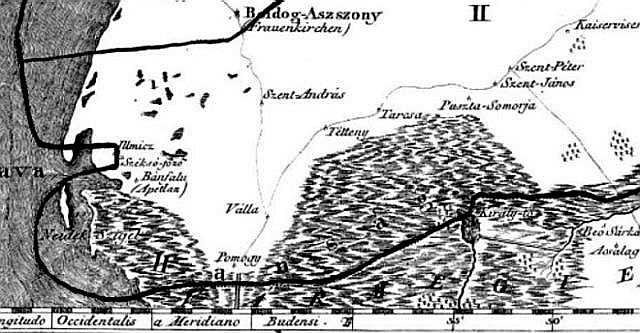 In earlier days, the Lake Corner was a very dangerous area to live. Several times, plagues, such as diphtheria or cholera, killed many people and shrank village populations. The main cause of such plagues was the swamp on the south side of the lake and beside it. Many insects and an always moist landscape brought other plagues. 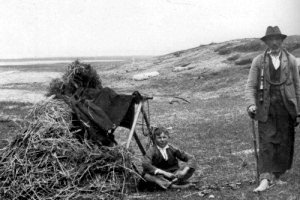 Also,
the nearby flat lands (or "Puszta", in Hungarian) were used as a herdsmen's grounds, with many
herds of horses, pigs, and sheep, which caused the collapse of clean drinking water. Many
water wells were poisoned, and, as a result, both people and animals died. Finally, the houses
were roofed with reeds, so if one rooftop burned, the whole village would burn down. Also,
the nearby flat lands (or "Puszta", in Hungarian) were used as a herdsmen's grounds, with many
herds of horses, pigs, and sheep, which caused the collapse of clean drinking water. Many
water wells were poisoned, and, as a result, both people and animals died. Finally, the houses
were roofed with reeds, so if one rooftop burned, the whole village would burn down. But
after recognizing the connections, the problems became solvable. Also, drying the so-called
"Hanság" swamp, the area between some villages like Tadten or Andau and the southern border to
Hungary, made the land useful, producing many crops. The houses changed from mud huts to real
stone or brick, built with a tiled roof. But
after recognizing the connections, the problems became solvable. Also, drying the so-called
"Hanság" swamp, the area between some villages like Tadten or Andau and the southern border to
Hungary, made the land useful, producing many crops. The houses changed from mud huts to real
stone or brick, built with a tiled roof.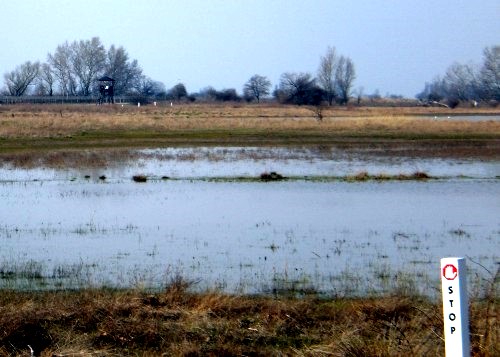 After
the start of tourism about 1960, everything changed. Many areas beside the lake become camping
areas. Some restaurants were established, every house got some bed-and-breakfast rooms, and
water sports grew. Everybody looked to establish their own part in this business. Some new
factories started, like yacht builders and sportswear manufacturers. The crops also changed,
from grain and cereals to wine and fruits, mostly apples. Many farmers changed everything and,
as a result, they needed new engines and vehicles. The Puszta disappeared and the rest of the
swamp became a national park, devoted in part to saving some species of birds. Thus, the park
became an attraction for ornithological tourists. After
the start of tourism about 1960, everything changed. Many areas beside the lake become camping
areas. Some restaurants were established, every house got some bed-and-breakfast rooms, and
water sports grew. Everybody looked to establish their own part in this business. Some new
factories started, like yacht builders and sportswear manufacturers. The crops also changed,
from grain and cereals to wine and fruits, mostly apples. Many farmers changed everything and,
as a result, they needed new engines and vehicles. The Puszta disappeared and the rest of the
swamp became a national park, devoted in part to saving some species of birds. Thus, the park
became an attraction for ornithological tourists. |
5) DNA AND OUR CROATIAN ROOTS (by Frank Paukowits)  We
currently have about 100 men participating in our Burgenland Study Project, which has enabled
us to begin to draw preliminary conclusions on what their DNA shows. We
currently have about 100 men participating in our Burgenland Study Project, which has enabled
us to begin to draw preliminary conclusions on what their DNA shows.Up until recently, we were perplexed because our Croatian profile of participants did not match the perceived distribution of haplotypes in present-day Croatia. Essentially, it was believed that Croatia had a large I2a2 haplotype concentration, whereas, many of our Croatian-sounding participants belonged to the R1a1 haplotype. We could not readily explain this aberration. However, in 2012, a new study of 1100 Croatian men was released that broke down their haplotypes by geographic region, which served to refine that longstanding belief to some degree. The results of the study were presented in a paper by Gordan Mršić and a group of researchers from Croatia, the Czech Republic and the United States. Because there was a sizable test population, the data could be analyzed from the standpoint of different regions within the country.  The data was broken down for five different regions: Central, Northern, Eastern, Southern and Western Croatia. The four most common haplotypes were I2a2, R1a1, E1b1b and R1b. These haplotypes accounted for nearly 80 percent of the entire group. The I2a2 group made up 37.7 percent, or nearly half of the 80 percent. The R1a1 was the second largest with 22.1 percent. But, there were significant differences between the various regions. The Northern Region actually had more R1a1’s than I2a2’s. And the Central Region had the second highest concentration of R1a1’s. As indicated in past BB Newsletters, these two regions were the most likely places from which our Burgenland ancestors likely migrated. What does this all mean?
This analysis indicates how DNA can be used to corroborate—and sometimes refute—recorded
history and our conventional genealogy research. It is a powerful tool but, unquestionably,
not a substitute for our research and analysis of written records and documents. |
6) HISTORICAL BB NEWSLETTER ARTICLES Editor: This is part of our series designed to recycle interesting articles from the BB Newsletters of 10 years ago. This month, I reprint one from NL 118A (May 31, 2003). Although his message is 10 years old, Mike Huber's recommendation of the Canadian Archives remains valid and accurate. Perhaps the only additional thing worth mentioning is that these Archives have continued to grow over the past 10 years; Mike's statement that "the search engine very user-friendly and FREE" remains true today. THE BURGENLAND BUNCH NEWS No. 118A May 31, 2003 CANADIAN ARCHIVES (from Mike Huber) Viele Grüße aus New York sendet Ihnen Mike Huber. I enjoy your monthly newsletter. Recently, I have enjoyed some success in researching my family history in Canada and I thought I would share it with you. You can determine if you want to pass it on to the Bunch. Like many of the Burgenlanders in the 1920s, my grandfather and his brothers emigrated from Austria (Unterschützen) to North America. Some of his brothers came directly to the United States, but others went to Canada to work in logging companies. Supposedly, the logging companies would pay the fare from Europe to Canada in exchange for one year's labor with the company. After that year, men were free to either stay in Canada or emigrate to the US (I'm still researching this fact.) My grandfather and a few of his other brothers took advantage of this opportunity in the mid- to late-1920s, to escape the depression in Austria.
I would encourage anyone interested to check it out. My grandmother left Illmitz in 1929,
to visit her brother in Manitoba, Canada (he had left Illmitz in 1924). She met my grandfather
on the ship and the rest is history. After one year in Canada, they met in Toronto and were
married, later returning to Austria and then to the U.S. in the mid 1950s. |
7) ETHNIC EVENTS LEHIGH VALLEY, PA (courtesy of Bob Strauch) Saturday, June 15: Bayrischer Biergarten at Emmaus Community Park. Sponsored by the Lehigh Sängerbund. Music by the Emil Schanta Band. Info: www.lehighsaengerbund.org Sunday, June 23: 96th Stiftungsfest of the Coplay Sängerbund. Choral Concert at 2 PM with the Coplay Sängerbund Chorus, the Hianz'nchor, the Reading Liederkranz Chorus, and the Lancaster Liederkranz Hobbychor. Dance in the pavilion 4-8 PM with the Josef Kroboth Orchestra. LANCASTER, PA Tuesday, June 4, 5:30 to 7:30 pm: First Tuesday Buffet (Members $10 - Guests $12). Lancaster Liederkranz. Entertainment by Carl Heidlauf. Friday & Saturday, June 7-8, 6-11 pm & 1-11 pm: A German Sommerfest. Lancaster Liederkranz ($5 Adult ~ $2 Child, 6-15 yrs). Music by Hank Haller (Friday), Phila. German Brass Band (Saturday afternoon), and Walt Groller (Saturday evening). Performances by Club Organizations, German Music, Food, Drink, Song & Dance. NEW BRITAIN, CT Friday, June 7, 7 pm: Heimat Abend. Austrian Donau Club, 545 Arch Street, New Britain, CT (860 223-9401). Music by Joe Rogers. Friday, June 21, 7 pm: Heurigan Abend. Austrian Donau Club. Music by Schachtelgebirger Musikanten. |
8) BURGENLAND EMIGRANT OBITUARIES (courtesy of Bob Strauch) Stephen Steiger  Stephen
Steiger, 76, of Northampton, Pennsylvania, died unexpectedly on Monday, May 6, 2013 in Lehigh
Valley Hospital, Muhlenberg. Stephen
Steiger, 76, of Northampton, Pennsylvania, died unexpectedly on Monday, May 6, 2013 in Lehigh
Valley Hospital, Muhlenberg.He was the husband of Rosemarie (Tomasitz) Steiger. He was born in Szentpéterfa (aka Petrovo Selo/Prostrum), Hungary on December 13, 1936 to the late John and Jozeffa (Filipovits) Steiger. Stephen owned and operated Steiger Construction before his retirement. During this time he was a bartender and lifelong member of the Ss. Peter and Paul Society and the St. Nicholas Ukrainian Home Assn. He was also a lifelong member of the Northampton Liederkranz and the Alliance Fire Company. He was an active member of the Queenship of Mary Catholic Church, where he served as an usher and member of the Holy Name Society. Steve was a loving husband, father, and grandfather who touched the lives of everyone he met. Survivors: In addition to his loving wife, Rosemarie, of 52 years; brothers, John Steiger of Vancouver, Canada and the late Vincent Steiger of Szentpéterfa, Hungary; daughter, Judy, wife of Richard Gogel Jr., of Northampton; son, Stephen (Shtip) Steiger Jr., also of Northampton; granddaughter, Tara Kleppinger of Northampton; and stepgrandson, Tanner Gogel. He is also survived by very close nieces, nephews, and cousins. Services: A Burial Mass will be celebrated on Saturday, May 11, at 10 a.m., at the Queenship of Mary Catholic Church located at 1324 Newport Ave., Northampton, PA. Family and friends may call on Friday, May 10, between the hours of 6 and 8 p.m., and Saturday, 8:30 to 9:30 a.m., in the Reichel Funeral Home located at 326 E 21st St., Northampton, PA. Burial will follow in the Queenship of Mary Parish Cemetery. Contributions: Memorials may be presented to the church c/o funeral home. Published in Morning Call on May 9, 2013 Eve Matthews  Eve
Matthews (née Kulovits), of Sonoma, California, passed away on Sunday, May 5, 2013. Eve
Matthews (née Kulovits), of Sonoma, California, passed away on Sunday, May 5, 2013.A native of Neuberg, Burgenland, Austria, she was born on December 19, 1919. She came to the United States at the age of seven. She grew up in Chicago and moved to Los Angeles in the early 1940's. A resident of Glen Ellen for nearly 30 years, she is survived by her two children; Carol and James Elkins; her grandchildren; Julie, Michelle and Paul; she was the beloved sister of Ann Howard and dear cousin of Olga Kulovitz. Eve's professional career began at Lawry's restaurant in Los Angeles where she was employed for 20 years. She then pursued a career as a medical bookkeeper, having worked for a prominent cardiologist in Pasadena for almost two decades. From her role as Cub Scout Den Mother in the late 50s and early 60s, to her later pursuits as a docent at the DeYoung Museum in San Francisco, Eve was also a volunteer docent at the Sonoma Historical Society Depot Museum, and participated in activities of The Ladies Guild of St Leo's Catholic Church in Sonoma. Giving something back to the church and community was always her objective. Eve was absorbed with the art of letter writing and expanded her correspondence to a wide community of friends and acquaintances around the world. As an avid reader of the "New York Times", many people became the recipients of her "clippings" on their particular subjects of interest. Among her correspondents were San Francisco's Herb Caen, and Charlie Rose of New York. Eve's family and friends will always remember her selflessness and devotion in caring for elder individuals who were either alone or unwell. A loving mother, grandmother, sister, cousin and friend, she will be missed. Friends are invited to attend a Funeral Mass at St Leo's Catholic Church, 601 West Agua Caliente Road, Sonoma, CA 95476, on Saturday, May 18, 2013 at 2:00 p.m. Duggan's Mission Chapel Mission Cremation Service 525 West NapaStreet, Sonoma, CA. Published in the Press Democrat from May 14 to May 15, 2013 Karl Varga  Karl
"Charlie" Varga, 79, passed away in Arizona on May 17, 2013. Karl
"Charlie" Varga, 79, passed away in Arizona on May 17, 2013.He was married to Irene (Vargo) Varga for 54 years. Born in Dürnbach, Austria, he was a son of the late Karl and Maria (Karlovits) Varga. Karl was a member of UFCW 1546, St. Gen's Friendship Club and also a long time board member of the Burgenländische Gemeinschaft/Chicago Chapter. Survivors: wife, Irene; daughters, Carol (Lou) Perri, Judy and Vicky; uncle, Frank Horvath; nieces and a nephew, many cousins and dear friends. He was predeceased by brothers Josef (Erika) Varga and Vincent (Waltraud) Karlovits. Services: visitation Friday 3PM – 9PM at Skaja Terrace Funeral Home 7812 N. Milwaukee Ave., Niles, IL. Funeral Saturday 9:00 AM to St. Thecla Church for 10 AM Mass. Interment in St. Joseph Cemetery. Funeral Info: 847-966-7302 or www.skajafuneralhomes.com |
END OF NEWSLETTER |
NOTICE (Terms and Conditions): The Burgenland Bunch (BB) was formed and exists to assist Burgenland descendants in their research into their heritage and, toward that end, reserves the right to use any communication you have with us (email, letter, phone conversation, etc.) as part of our information exchange and educational research efforts. • If you do not want your communication to be used for this purpose, indicate that it is "confidential" and we will abide by that request. • Correspondents who communicate with the BB without requesting confidentiality retain their copyright but give a non-exclusive license to the BB allowing us to forward to BB members, publish in our monthly newsletter or on our website, and/or subsequently and permanently archive all or parts of such communications. The Burgenland Bunch homepage (website) can be found at: http://www.the-burgenland-bunch.org/ Burgenland Bunch Newsletter, copyright © 2013 by The Burgenland Bunch All rights reserved. Permission to copy excerpts granted if credit is provided. |
 News
News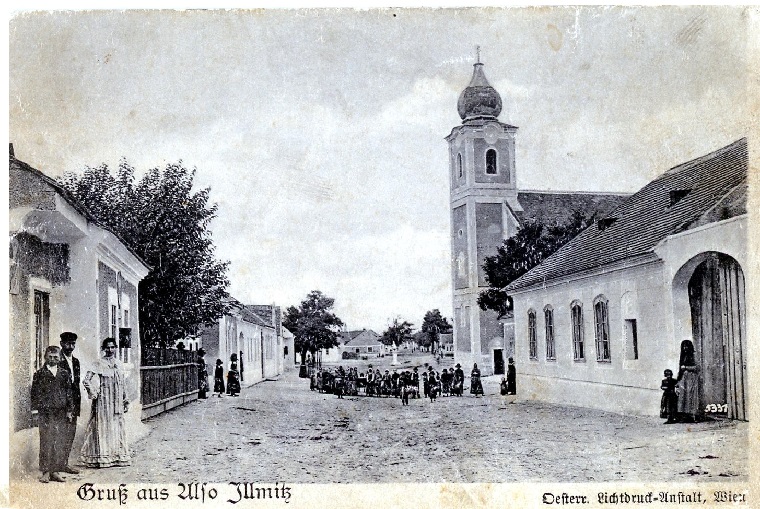
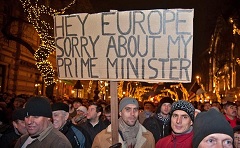 Orban
was gifted his two-thirds majority in 2010 by the spectacular collapse of the outgoing
corrupt and incompetent (but pro-EU and international banking-friendly) Socialist
government. The fact that he has taken advantage of this to concentrate power in the hands
of the ruling party, and to game the system to increase the likelihood of that ruling
party being Fidesz, is a sign of his weakness and insecurity, and not his strength. For my
part, I don’t understand why Orban feels to the need to do this.
Orban
was gifted his two-thirds majority in 2010 by the spectacular collapse of the outgoing
corrupt and incompetent (but pro-EU and international banking-friendly) Socialist
government. The fact that he has taken advantage of this to concentrate power in the hands
of the ruling party, and to game the system to increase the likelihood of that ruling
party being Fidesz, is a sign of his weakness and insecurity, and not his strength. For my
part, I don’t understand why Orban feels to the need to do this.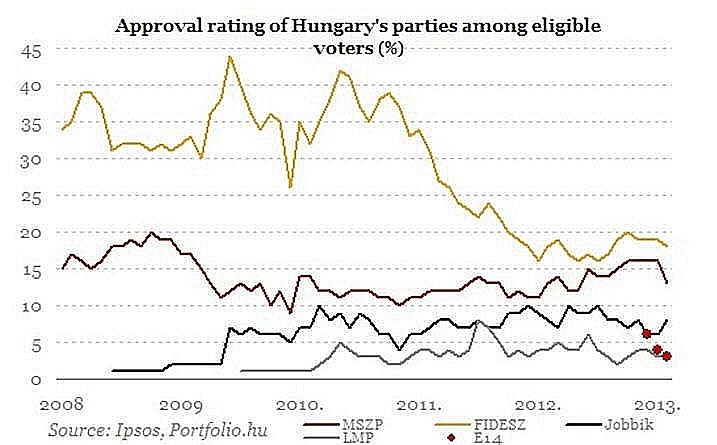
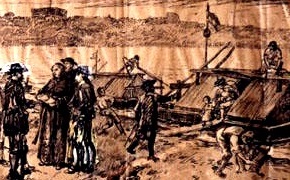 Interestingly,
Rosina T. Schmidt on webpage
Interestingly,
Rosina T. Schmidt on webpage 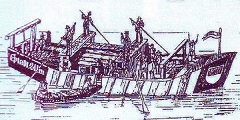 Being
forced to stop in Vienna may explain why some of these people ended up in Burgenland… clearly
it was a convenient place for our local landowners (nobility and churches) to entice colonists
to settle on their land instead. [Ed. addition: Webpage
Being
forced to stop in Vienna may explain why some of these people ended up in Burgenland… clearly
it was a convenient place for our local landowners (nobility and churches) to entice colonists
to settle on their land instead. [Ed. addition: Webpage
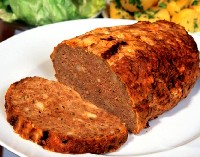 1
lb. beef, chopped 1 Tbsp.
onion, chopped
1
lb. beef, chopped 1 Tbsp.
onion, chopped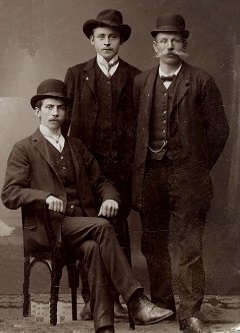 Quote
of the Month: Sometimes one runs across a quote in a book that is so picturesque that
it is well-worth sharing wider. Given we family history researchers often collect old family
pictures, I thought I'd share a quote from "The Stranger House" by Reginald Hill (Seal
Books, 2006) about such old pictures:
Quote
of the Month: Sometimes one runs across a quote in a book that is so picturesque that
it is well-worth sharing wider. Given we family history researchers often collect old family
pictures, I thought I'd share a quote from "The Stranger House" by Reginald Hill (Seal
Books, 2006) about such old pictures: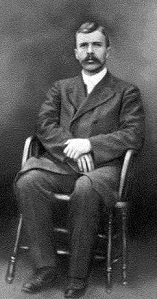 Note
that the Bloomfield Theological Seminary was originally called the German
Theological School of Newark, NJ, located at Bloomfield, NJ, c. 1905. Additionally, the
1907 Newark Directory shows my grandfather's residence as 119 Peshine Avenue, and then at 106
Avon Avenue, Newark in 1909. My father Lazlo (Leslie), the youngest of four sons, was born May
1909 at home.
Note
that the Bloomfield Theological Seminary was originally called the German
Theological School of Newark, NJ, located at Bloomfield, NJ, c. 1905. Additionally, the
1907 Newark Directory shows my grandfather's residence as 119 Peshine Avenue, and then at 106
Avon Avenue, Newark in 1909. My father Lazlo (Leslie), the youngest of four sons, was born May
1909 at home.